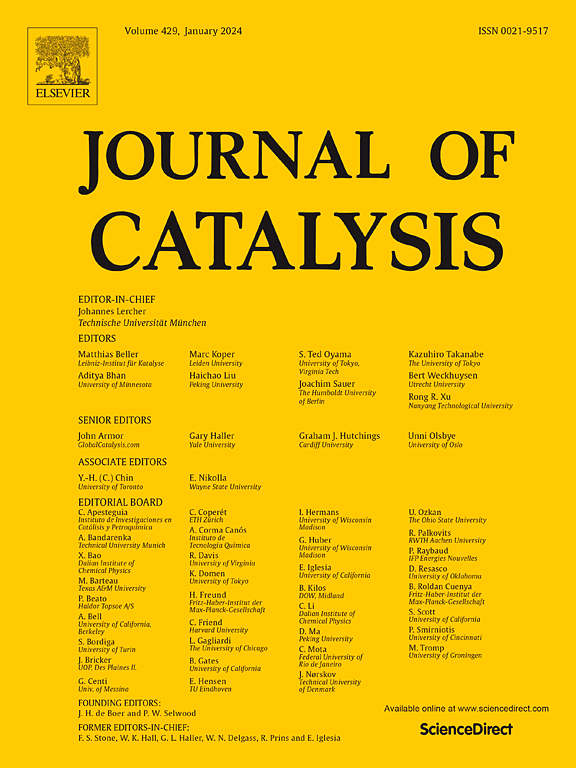TiO2表面的羟基促进了α-C自由基和恶氮吡啶中间体在胺氧化成肟过程中的形成
IF 6.5
1区 化学
Q2 CHEMISTRY, PHYSICAL
引用次数: 0
摘要
通过好氧氧化在胺中构建N - O键是制备环己酮肟的重要途径;然而,这一机制仍存在争议。关于TiO2/NHPI共催化环己胺有氧氧化,本文论证了一个以α-C自由基和恶氮吡啶为关键中间体的令人信服的机制。电子顺磁共振、质谱分析和甲基化底物的产物分析都证明了环己胺自由基的易位和1-羟基过氧环己胺的环氧化反应都是通过双质子转移介导的,是胺转化为肟的关键。近红外分析表明,TiO2表面羟基有利于双质子转移过程。在这里,表面羟基在TiO2上的作用突出了其在胺活化方面的广泛应用潜力。此外,完善的自由基机制为胺中N−O键的构建提供了有价值的见解。本文章由计算机程序翻译,如有差异,请以英文原文为准。


Surface hydroxyl on TiO2 promoted formation of α-C radical and oxaziridine intermediates in aerobic oxidation of amine into oxime
Constructing N−O bond in amines via aerobic oxidation is of high interest for producing cyclohexanone oxime; however, the mechanism remains disputed. Concerning TiO2/NHPI co-catalyzed aerobic oxidation of cyclohexylamine, here a convincing mechanism involving α-C radical and oxaziridine as key intermediates is demonstrated. All the evidences from electron paramagnetic resonance, mass spectrometry, and product analysis with methylated substrates lead to the same story about the mechanism, where both radical translocation of cyclohexylamino radical and epoxidation of 1-hydroperoxycyclohexylamine are mediated by double proton transfer and are the key to convert amine into oxime. Near IR analysis indicate that surface hydroxyl groups on TiO2 facilitate the double proton transfer process. Here the unveiled role of surface hydroxyl on TiO2 highlights its potential for broader applications in amine activation. Additionally, the well-established radical mechanism provides valuable insight into the construction of N−O bonds in amines.
求助全文
通过发布文献求助,成功后即可免费获取论文全文。
去求助
来源期刊

Journal of Catalysis
工程技术-工程:化工
CiteScore
12.30
自引率
5.50%
发文量
447
审稿时长
31 days
期刊介绍:
The Journal of Catalysis publishes scholarly articles on both heterogeneous and homogeneous catalysis, covering a wide range of chemical transformations. These include various types of catalysis, such as those mediated by photons, plasmons, and electrons. The focus of the studies is to understand the relationship between catalytic function and the underlying chemical properties of surfaces and metal complexes.
The articles in the journal offer innovative concepts and explore the synthesis and kinetics of inorganic solids and homogeneous complexes. Furthermore, they discuss spectroscopic techniques for characterizing catalysts, investigate the interaction of probes and reacting species with catalysts, and employ theoretical methods.
The research presented in the journal should have direct relevance to the field of catalytic processes, addressing either fundamental aspects or applications of catalysis.
 求助内容:
求助内容: 应助结果提醒方式:
应助结果提醒方式:


